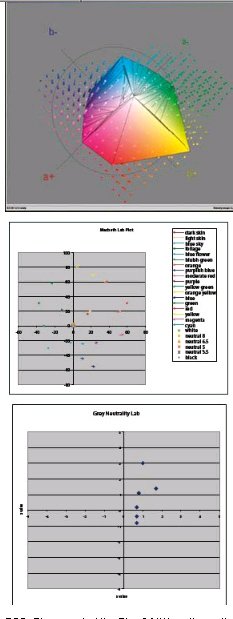articles/Monitors/eizocg241wmonitor-page3
Eizo colouredge cg241W monitor - part 3 of 1 2 3
by Mike McNamee Published 01/12/2007

The gamut volume measurement broke the record. BOTTOM: The gamut is similar in size to Adobe RGB, exceeding its reach in quite a few places. This extended gamut is what marks these high-end monitors out from the lower-priced competition.
Performance
The Color Navigator profile was not recognised by our X-Rite evaluation program and so we had to build a bespoke profile using Monaco profiler. As shown in the table, this delivered the highest gamut volume that we have measured to date off any device of any kind - the bar keeps rising. The screen grabs show the actual gamut in relation to Adobe RGB and FOGRA CMYK profiles. Although Eizo claim a 96% coverage of Adobe RGB we actually exceed it, we obviously had a monitor from the higher end of the variability scale. The Adobe RGB gamut was exceeded in the oranges, reds and cyans and (just) in the blues. Apart from a single value, the Eizo gamut swallowed the entire FOGRA gamut. Overall these data were very close to those obtained earlier in the year on the Eizo CG221.
The colour precision values were not quite as high as we anticipated from our results with the CG221 but at 1.76 ΔE Lab/1.29ΔE 2000 they would be considered a 'match'. We tried a number of dodges to improve the values but failed to do so. There was a slight warmth to the neutral greys which showed when viewing monochrome images and also shows in the plotted data. The error data became more neutral after an overnight restart, but then we found that the luminance component had shifted to create the largest error portion. This amounted to about 2.5% too dark over the Macbeth swatches. We thought about hand tweaking the settings but got that 'only touch that button if you think you're hard enough' look from Fido!

TOP: The gamut of the Eizo 241W swallows all parts of the FOGRA CMYK printing gamut, essential for truly accurate rendition of printing colours on the screen.
MIDDLE: The usual audit of the Macbeth Chart colours shows very small overall errors.
BOTTOM: The residual error left the rendering of monochromes just a little warm, as confirmed by this graph. The data points from the Macbeth greys are a couple of points into the right quadrants of the Lab chart, ie warmer.
The Achilles' heel of the mid-range LCDs is their luminance control as we have said, and their inability to operate at the ISO standard of 95 cd/m2. In practice this usually means that you see more in the shadows of an on-screen image than a well-profiled inkjet printer will deliver. The Eizo displayed shadow blocking at between 15 and 20 RGB points, just where it happens in a paper print - an excellent result, then.
The electronics of the CG241W include a 12-bit LUT, giving a palette of 4,081 for each of the red, green and blue tones. The quality of the Granger Chart is very smooth with no obvious flaws or discontinuities. It is not reproduced here because, by definition, it is almost 100% out of gamut in CMYK printing. The monitor also features Digital Uniformity Equalisation (DUE) which smoothes out any differences in luminance across the screen and out to the corners. Every monitor is provided with the actual quality control chart, displaying the measured (small) errors across the entire screen.
OVERALL We remain impressed by the Eizo technology in their high-end monitors and would take the decision to invest the extra simply for peace of mind. The ease of calibration, the accuracy of that calibration and the five-year warranty all make for a package that is worth paying extra for. The decision on size is trickier; our own preference would be for a smaller screen, combined with an inexpensive second screen. If, however, you need colour precision across the full 24-inch diagonal then this is a good way of achieving it.
The CG241W costs £1,149.00 ex VAT and not including a calibration device.
See also
www.eizo.com
www.colourconfidence.com
Please Note:
There is more than one page for this Article.
You are currently on page 3
- Eizo colouredge cg241W monitor page 1
- Eizo colouredge cg241W monitor page 2
- Eizo colouredge cg241W monitor page 3
1st Published 01/12/2007
last update 09/12/2022 14:53:44
More Monitors Articles
There are 0 days to get ready for The Society of Photographers Convention and Trade Show at The Novotel London West, Hammersmith ...
which starts on Wednesday 15th January 2025





